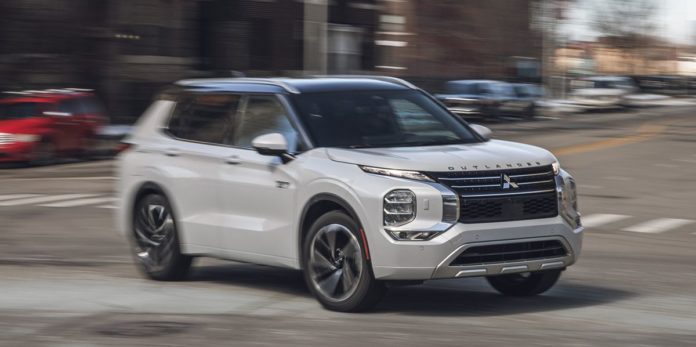From the June 2023 Issue of Car and Driver.
Like a shape-shifter, Mitsubishi has been many things. First known to Americans as the maker of gas-stingy little Dodges and Plymouths, Mitsubishi went on to produce its own econoboxes, sporty coupes, high-strung sport compacts, and off-road-ready SUVs. Repeatedly, though, changing markets or a wave of competitors washed out the ground beneath Mitsu’s feet. The brand’s latest niche is the plug-in-hybrid compact crossover. Its Outlander PHEV, sold here since 2018, enters its second generation for 2023—but the floodwaters of competition are already rising.
A corporate tie-up with Nissan means the latest Outlander is based on the Nissan Rogue, but the two look nothing alike. Under the hood is Mitsubishi’s engine: a 131-hp Atkinson-cycle 2.4-liter inline-four aided by three electric motors, one of which drives the rear wheels.
The powertrain makes a combined 248 horsepower (versus the base engine’s 181) and 332 pound-feet of torque. Even though the PHEV weighs 4751 pounds—a whopping 887 more than the regular Outlander—it’s still 1.6 seconds quicker to 60 mph, reaching the mark in 6.6 seconds. With that time, it can’t match the 302-hp Toyota RAV4 Prime but beats the Ford Escape and Kia Sportage PHEVs. And in EV mode, the electric motors have enough thrust to move you around town.
The new, larger battery (an estimated 16.8-kWh pack) can be replenished by the engine or by plugging in. A DC fast-charger took the depleted battery to 94 percent in 61 minutes. The EPA estimates 38 miles of EV range; in our 75-mph highway test, we went 24 miles before the engine fired up.
Other modes can add to or preserve the battery’s state of charge or just let the system decide the motive mix. The standard digital instrument cluster keeps tabs on the hybrid system’s noisy machinations, although the readout isn’t easy to follow. Paddles adjust brake regeneration, and a console button brings nearly one-pedal driving. Using the actual brake pedal is not so satisfying, with lots of dead travel. Still, our 171-foot stop from 70 was acceptably short.
Midcorner bumps can set the body into a corkscrew motion, and hitting one usually results in a shock reverberating through the cabin.
That cabin—which is similar to a top-spec Rogue’s—is roomy, except for the third row, which is so small as to be strictly theoretical. Our top-level SEL S-AWC example came with the ritzy SEL Premium package (semi-aniline leather, a panoramic sunroof, massaging front seats, and more) for $2700.
Despite the fancy cabin, the $50,980 as-tested price gives us the sweats. The similarly pricey RAV4 Prime drives better, while the Escape and the Sportage cost less. For compact-SUV buyers, the Outlander PHEV offers a way to ease into electrification. But for Mitsubishi, an influx of competitors means it may not be much of a safe haven for long.
Specifications
Specifications
2023 Mitsubishi Outlander PHEV SEL S-AWC
Vehicle Type: front-engine, front- and rear-motor, all-wheel-drive, 7-passenger, 4-door wagon
PRICE
Base/As Tested: $46,890/$50,980
Options: Premium package (power panoramic sunroof, heated steering wheel, synthetic leather door inserts, semi-aniline seat leather seats, 10.8-inch head up display, Bose sound system, front seat massage), $2700; White Diamond/Black roof, $995; tonneau cover, $200; Welcome package (touch-up paint pen, carpeted floor mats, cargo floor liner, tray mat), $195
POWERTRAIN
DOHC 16-valve 2.4-liter inline-4, 131 hp, 144 lb-ft + AC motors, 114 and 134 hp, 188 and 144 lb-ft (combined output: 248 hp, 332 lb-ft; 16.8-kWh lithium-ion battery pack, C/D est)
Transmissions, F/R: continuously variable automatic/direct-drive
CHASSIS
Suspension, F/R: struts/multilink
Brakes, F/R: 13.8-in vented disc/13.0-in vented disc
Tires: Nexen Roadian GTX RG1
P255/45R-20 101W M+S
DIMENSIONS
Wheelbase: 106.5 in
Length: 185.4 in
Width: 73.2 in
Height: 68.7 in
Passenger Volume, F/M/R: 54/46/18 ft3
Cargo Volume, Behind F/M/R: 64/31/13 ft3
Curb Weight: 4751 lb
C/D TEST RESULTS
60 mph: 6.6 sec
1/4-Mile: 15.8 sec @ 82 mph
100 mph: 31.9 sec
Results above omit 1-ft rollout of 0.3 sec.
Rolling Start, 5–60 mph: 6.7 sec
Top Gear, 30–50 mph: 3.6 sec
Top Gear, 50–70 mph: 5.1 sec
Top Speed (C/D est): 110 mph
Braking, 70–0 mph: 171 ft
Roadholding, 300-ft Skidpad: 0.85 g
C/D FUEL ECONOMY
Observed: 27 MPGe
75-mph Highway Driving, EV/Hybrid Mode: 44 MPGe/25 mpg
75-mph Highway Range, EV/Hybrid mode: 24/370 mi
EPA FUEL ECONOMY
Combined/City/Highway: 26/25/27 mpg
Combined Gasoline + Electricity: 64 MPGe
EV Range: 38 mi
C/D TESTING EXPLAINED
Deputy Editor, Reviews and Features
Joe Lorio has been obsessed with cars since his Matchbox days, and he got his first subscription to Car and Driver at age 11. Joe started his career at Automobile Magazine under David E. Davis Jr., and his work has also appeared on websites including Amazon Autos, Autoblog, AutoTrader, Hagerty, Hemmings, KBB, and TrueCar.

